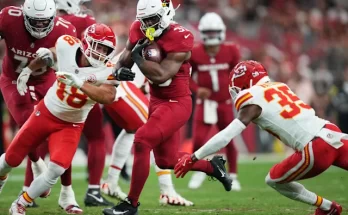Kansas City Radio Host Kevin Kietzman Reveals Major Shift: Chiefs Pull Out of Kansas Stadium Plans, Committed to Arrowhead; Royals Cement Future Strategy.
In a development that has sent shockwaves across both sides of the Missouri-Kansas border, Kansas City sports radio personality Kevin Kietzman dropped a bombshell on his show, revealing that the Kansas City Chiefs have officially backed out of any stadium negotiations with Kansas. The long-standing speculation about the team’s possible move across the state line has come to an abrupt end, with sources confirming that the franchise is now fully committed to remaining at their historic home, Arrowhead Stadium. Simultaneously, the Kansas City Royals have reportedly locked in their own future plans, setting the stage for major sports infrastructure decisions that will define the region for decades.
For months, whispers and reports suggested that the Chiefs were seriously considering relocating to Kansas, particularly after Jackson County voters in Missouri rejected a sales tax extension that would have helped fund renovations and improvements for Arrowhead Stadium and a new downtown stadium for the Royals. The setback had prompted both teams to explore alternatives, with Kansas emerging as a viable and attractive option due to favorable legislative conditions and incentives offered by officials eager to secure a marquee NFL franchise. However, Kietzman’s report indicates that the Chiefs have shut down those exploratory talks entirely and are no longer entertaining any possibility of abandoning their Missouri roots.
According to multiple people familiar with the internal deliberations, the Chiefs’ leadership—spearheaded by Chairman and CEO Clark Hunt—decided to double down on Arrowhead after a comprehensive review of options, public feedback, and logistical assessments. It appears that the emotional and historical value of Arrowhead, combined with the complications of a potential move, proved too significant to ignore. The decision reportedly came after weeks of quiet discussions with Missouri state leaders, business stakeholders, and team officials, all aimed at creating a new plan to keep the NFL franchise in its traditional home without the originally proposed tax support.
Kietzman’s revelation isn’t just a minor update; it effectively ends the months-long speculation that had both thrilled and alarmed fans depending on which side of the state line they resided. Kansas lawmakers had been preparing legislation that would allow for a unique financing package, including STAR (Sales Tax and Revenue) bonds, to fund the construction of a new stadium in the Kansas City, Kansas, area. There had been back-and-forth discussions about potential sites, including areas near Village West and the Kansas Speedway. Now, with the Chiefs out of the picture, those plans are likely to be shelved, if not scrapped altogether.
The impact of the decision extends beyond football. For Kansas, losing out on the Chiefs represents a significant economic and cultural setback. The opportunity to attract one of the most successful franchises in the NFL—fresh off multiple Super Bowl appearances and wins—was seen as a once-in-a-generation chance to boost tourism, generate jobs, and enhance statewide prestige. While Kansas lawmakers remain optimistic about future sports or entertainment projects, this loss leaves a noticeable void in their strategic development agenda.
On the Missouri side, the Chiefs’ decision signals both relief and urgency. Local officials must now navigate how to support the team’s long-term vision for Arrowhead without relying on the failed tax package. Sources indicate that alternative funding mechanisms, including private investment, naming rights expansions, and targeted state-level support, are being explored to cover the estimated hundreds of millions in needed upgrades. Arrowhead Stadium, though beloved and iconic, is one of the oldest venues in the league. While it still delivers an unparalleled fan experience and retains its status as one of the loudest stadiums in the NFL, there is consensus that modernization is necessary to maintain that competitive edge.
Interestingly, this announcement from Kietzman also sheds light on the Royals’ plans, which have now reportedly reached a level of finality. While the Royals were initially partnered with the Chiefs in seeking public support for a dual stadium project through the same tax package, their path appears to be diverging in a significant way. Sources close to the team suggest that Royals owner John Sherman and his group have settled on a specific site for a new downtown ballpark, though the details have yet to be publicly announced. The Royals’ project, estimated to cost over \$2 billion including surrounding development, will likely proceed through private financing, new investment partners, or alternative public support models, possibly through city-level initiatives.
For Kansas City as a whole, these developments represent a pivotal turning point in the city’s sports identity. With both teams moving forward on distinct tracks, it marks the end of the once-conjoined stadium dream that envisioned a unified path forward at the Truman Sports Complex or a fresh start elsewhere. The Chiefs’ recommitment to Arrowhead maintains a deep-rooted tradition, honoring a stadium that has been home to generations of fans since 1972. For many, that continuity offers a sense of reassurance, especially amid an increasingly transient sports landscape where teams often chase new markets or newer facilities with lucrative amenities.
Fans across the metro area, especially in Missouri, are reacting with a mix of joy and curiosity. Social media exploded following Kietzman’s report, with many celebrating the Chiefs’ loyalty to their history. At the same time, questions abound: How will Arrowhead be upgraded without taxpayer funding? What specific changes are being prioritized? Will the project disrupt the game-day experience fans hold so dear? These are issues that team leadership will need to address transparently and swiftly.
Behind the scenes, NFL leadership is reportedly pleased with the Chiefs’ decision. League executives have long valued Arrowhead’s reputation as a flagship venue and a symbol of fan passion in the heart of America. Maintaining that legacy aligns with the NFL’s broader strategy of honoring tradition while modernizing infrastructure. Commissioner Roger Goodell is expected to address the decision at some point, possibly at an upcoming league event or press conference.
Meanwhile, the Royals’ path forward appears equally intriguing. With final plans nearing announcement, all signs point to a downtown stadium becoming a reality in the near future. The franchise sees the move not only as a way to boost attendance and rejuvenate the team’s brand but also as a catalyst for urban development. Early renderings and feasibility studies have pointed toward locations near the East Village or the Crossroads District, areas poised for growth and increased foot traffic.
One factor that will weigh heavily on both franchises is timing. With the Royals hoping to break ground soon and the Chiefs planning significant renovations to Arrowhead, the construction schedules, coordination with city services, and public engagement campaigns will all need to be carefully managed. The timeline will be crucial to avoid overlap, public confusion, or logistical nightmares that could diminish the broader benefit of these historic decisions.
Another layer to this evolving story is the political landscape. With Kansas losing its bid and Missouri now under pressure to assist both teams without the previous voter mandate, elected officials are walking a delicate tightrope. Any future proposals for financial assistance will likely face intense scrutiny. Public trust, shaken by the failed tax initiative, will need to be rebuilt through clear, consistent communication and transparent planning from all parties involved.
Kietzman’s credibility as a media figure, particularly within Kansas City sports circles, lends weight to this report, but insiders note that official statements from the Chiefs and Royals are expected soon to confirm the developments. Until then, city planners, fans, and businesses alike are all bracing for the ripple effects. Hotels, restaurants, and local vendors who depend on sports traffic will be watching closely to understand how the stadium decisions might affect their bottom lines over the next decade and beyond.
For the Chiefs, this new chapter represents a return to their roots and a reaffirmation of their identity. The organization has always prided itself on being part of the community, and staying at Arrowhead cements that relationship further. It also allows the team to maintain continuity as it enters a potential dynastic era led by quarterback Patrick Mahomes and head coach Andy Reid. Stability in stadium location ensures that focus can remain on building a lasting football legacy without the distraction of relocation politics.
For the Royals, the looming downtown move represents change, risk, and potential. Their future now hinges on how effectively they can execute a stadium development plan that not only revitalizes the team but also contributes meaningfully to the urban core. If successful, it could transform the landscape of Kansas City baseball for generations to come.
In the end, Kietzman’s report marks a monumental shift in the sports narrative of Kansas City. What once seemed uncertain and politically charged is now clearer. The Chiefs are staying home at Arrowhead, proud of their past and confident in their future. The Royals are forging ahead with their own bold move. For a city long defined by its passionate sports culture, this moment represents not just the end of speculation, but the beginning of two very different yet equally ambitious journeys.


